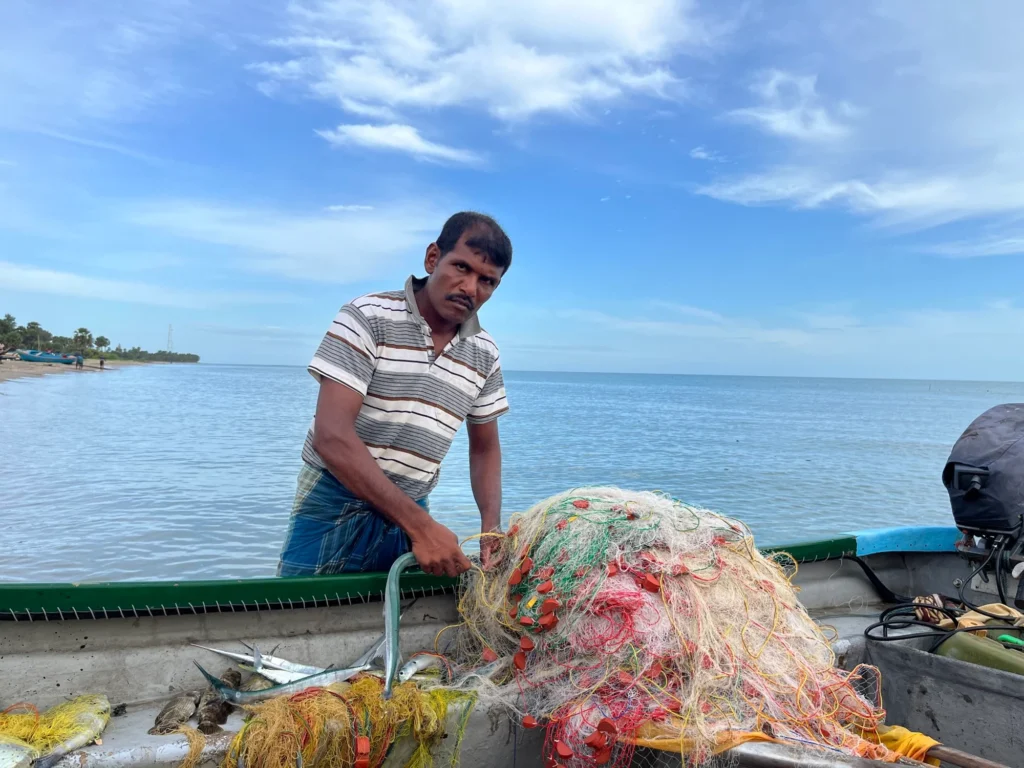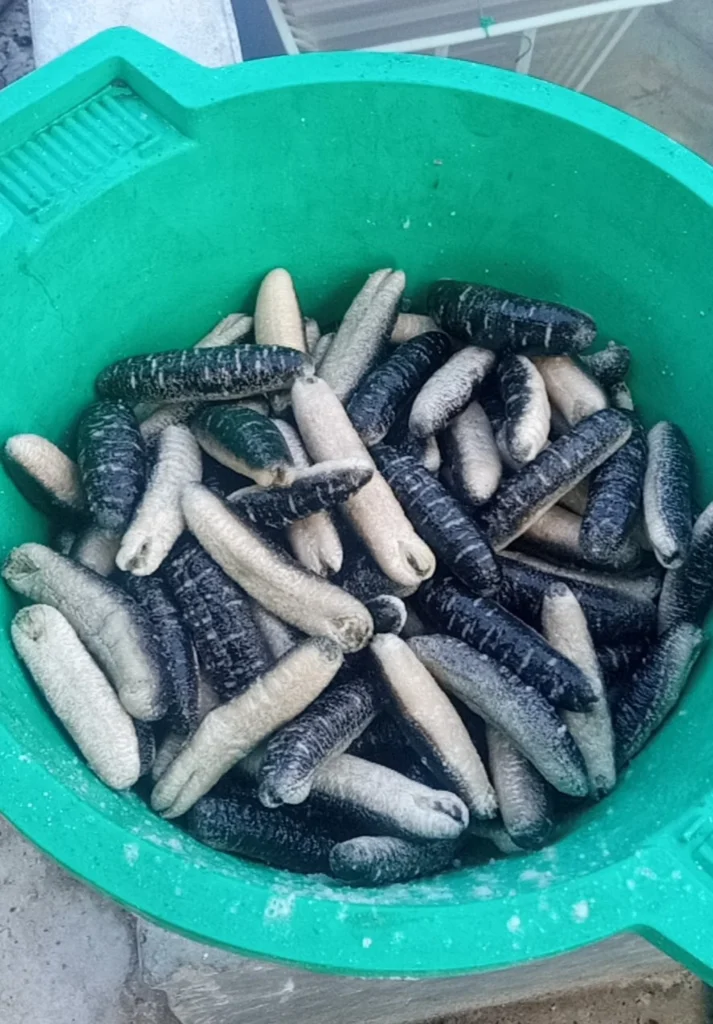- Indian boats have been illegally poaching in Sri Lanka’s waters, taking advantage of the country’s economic crisis and struggling fishermen
- Now a Beijing-owned venture has been helping them to cultivate sea cucumbers instead, to be exported to mainland China, Hong Kong and Taiwan
At 7am, Velupillai Rasaratnam, pushes his 15-feet long wooden boat closer to the Karainagar shore with the help of a younger fisherman in Sri Lanka’s war-torn Northern Province.
Wearing a black T-shirt and red shorts, the 70-year-old rows for around an hour, catching a few grey mullets that he plans to sell for 700 Sri Lankan rupees (US$2) at a local fish auction.
An hour is as far as his tired arms can take him. And as Sri Lanka reels from an acute economic crisis, it is increasingly clear that fishermen like Rasaratnam have borne the brunt of major fuel shortages.
With the price of kerosene quadrupling to 340 rupees (US$0.93) per litre, “I could not take my motorised boat to sea. Therefore, going too far wasn’t possible”, Rasaratnam said, adding that he goes fishing just twice a week these days.
Before the country went bankrupt, he used to go out every day to catch about 5kg of fish that earned his family of five around 5,000 rupees (US$13.89).
But kerosene was a scarce commodity even before the price hike in August, forcing many fishermen to buy it at 1,500 rupees (US$4.17) on the black market.
The availability and cost of fuel are not the only worrying issues fishermen are facing. In the last two decades more Indian boats have been making their way to Sri Lanka’s territorial waters to fish there, illegally.
“While we are confined to our homes due to a lack of kerosene, Indian fishermen are taking away all our resources,” said Rasaratnam.
Illegal fishing
Fishermen from India’s southern Tamil Nadu and Sri Lanka’s Northern Province are legally allowed to fish in the Palk Strait, a narrow strip of water between the two countries.
Three months ago, a representative of fishermen in Northern Province’s Mannar district appealed to Tamil Nadu’s chief minister to stop Indian fishermen from poaching in its smaller neighbour’s waters, especially at a time Sri Lanka is experiencing an economic crisis.
But that call went ignored. Last month, the Sri Lankan navy arrested at least 16 Indians for illegal fishing after they intruded into the island nation’s waters.
Kandasami Rajachandran, president of the Ambal Fishermen’s Cooperative in Karainagar, said that since the arrival of Indian trawlers, Sri Lankan fishers have for the past decade been bringing back just one basket of fish – weighing barely a kilo or two – whereas they used to return with six to eight earlier.
The foreign trawlers usually take away many kinds of marine life, including needlefish, emperor fish and prawns.
Rajachandran said the biggest catch that day was three stingrays weighing about 26kg each. “But we used to get much bigger stingrays earlier, now they are taken away by the Indian trawlers.”
The trawlers began intruding into Sri Lankan waters in 2002, he said, when fishermen in the north were banned from fishing as civil war raged between armed Tamil separatists and the Sri Lankan army.
Their livelihoods were further affected by the devastating tsunami that hit the Indian Ocean in 2004, he added.

Thankarasa Prakash, 40, another fisherman, who has often seen Indian trawlers near Karainagar, thinks his government has not addressed the problems caused by them because the Sri Lankans whose livelihoods are affected are mostly Tamils, an ethnic minority in the Sinhalese-majority country.
However, Sri Lanka’s fisheries minister Douglas Devananda, a Tamil politician, said the government had made several attempts to curb Indian fishing, but efforts had failed.
A new lifeline?
With the backdrop thus set, a Chinese company has stepped into the breach.
More than 1,000 fishermen in three northern districts – Mannar, Kilinochchi and Jaffna – are now cultivating sea cucumbers, a marine creature often seen as a delicacy in Chinese cuisine, as part of a venture between Gui Lan Hatchery and Sri Lanka’s national aquatic development authority.
The company, started in 2015, is run by four directors from mainland China and Taiwan.
Devananda said he was also encouraging fishermen to explore other “alternative sources of livelihood” like cultivation of seaweed and sea bass too.
Steven Gong, Gui Lan’s Taiwanese co-owner and administrative executive who has lived in Sri Lanka for more than 30 years and has three children with his Tamil wife, noted that the start-up costs for such operations were low, with an initial investment of 500,000 rupees (US$1,369) per acre for setting up infrastructure lasting five years.
Fishermen also get financial help from the International Labour Organization to buy juveniles from the hatchery.
Gong said his firm provided cultivators 60-day-old sea cucumbers weighing 1 gram for 60 rupees each (US$0.16).
“The farmers, including some fishermen, nurse the juveniles for 10 months until each weighs about 250 grams, then they are sold for 1500 rupees (US$4) to exporters,” Gong said. “But [those] cultivators who nurse the sea cucumbers for a few more months till they weigh 500g each, sell them for about 3,000 rupees (US$8).”
In 2021, Sri Lanka exported about 336 tonnes of sea cucumbers – prized for their soft interiors and chewy skin – to Singapore, mainland China, Hong Kong and Taiwan.
The government this year approved a large-scale commercial sea cucumber project of over 5,000 acres in the country’s northern and eastern districts.

M Thivagaran, president of the Jaffna Sea Cucumber Cultivators’ Association, said sea cucumber cultivation had given a ray of hope to fishermen suffering severe losses.
“Annually, a sea cucumber cultivator can earn a guaranteed sum of 1 million rupees (US$2,830), but a fisherman earns barely 480,000 (US$1,333), which is not guaranteed in the current economic scenario and at a time when Indian trawlers look unstoppable,” said Thivagaran. He said 300 fishermen in Jaffna, the capital of the Northern Province, had switched to sea cucumber cultivation since last year.
India-China rivalry
Critics have also raised concerns about the sea cucumber initiative as it comes at a time when China – one of Sri Lanka’s largest creditors with at least US$3.5 billion of outstanding loans – is being partly blamed for pushing the nation into a debt crisis.
Traditionally, India is seen to be closer to Sri Lanka’s north, largely because of the shared Tamil ethnicity, but China has also been making inroads in the region as both superpowers compete to gain a strategic edge over the island nation.
Last year, China’s ambassador in Sri Lanka, Qi Zhenhong, distributed rations to fishermen affected by Indian trawlers. In May this year, at the peak of the economic crisis, India sent 15,000 litres of kerosene to northern Sri Lanka’s fishermen.
Jaffna-based economist Vivekanandan Niranjan said Sri Lanka was allowing the India-China “geopolitical game” to play out in its territory because of the lack of political and economic stability.
Niranjan added that New Delhi and Beijing will use the island nation to settle scores with each other till it returns to normalcy.
“But both countries must understand that Sri Lankans are worried if the two are capitalising on the island’s current instability and using its territory as the playground,” he said.
